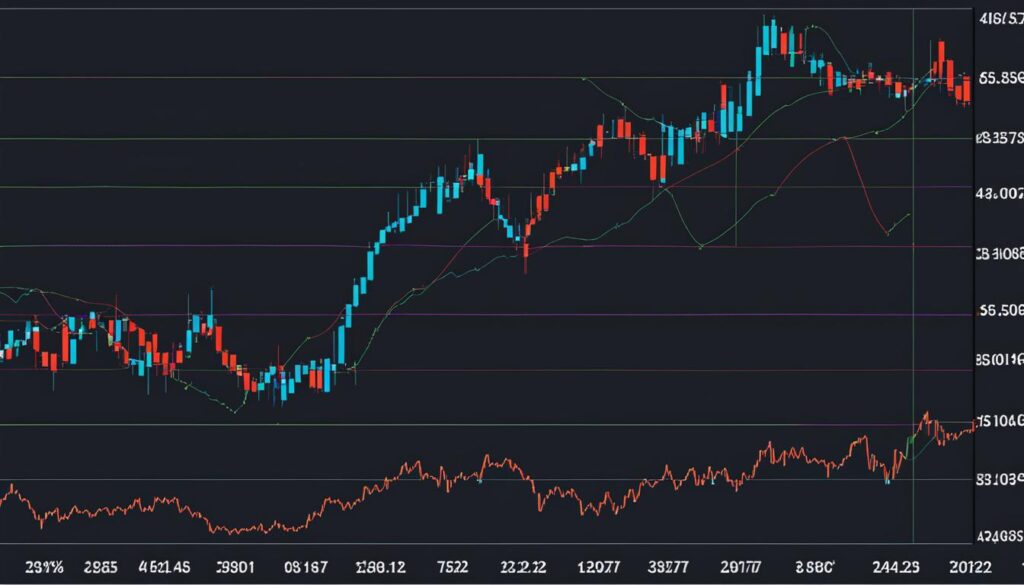In the world of options trading, volatility can present both opportunities and challenges. Traders who can navigate volatile markets have the potential to reap significant rewards. That’s where advanced options trading strategies like the straddle and strangle come into play.
When markets are volatile, predicting the direction of price movement can be challenging. That’s why the straddle and strangle strategies are so valuable. These strategies offer traders the opportunity to profit from significant price moves, regardless of whether the market goes up or down.
A straddle involves buying a call and put option at the same strike price and expiration date. This strategy is ideal when traders anticipate a substantial move in the price of an asset but are uncertain about the direction of the move. On the other hand, a strangle involves buying a call and put option with different strike prices but the same expiration date. This strategy is suitable when traders expect a significant price move but are unsure about the direction.
Key Takeaways:
- Advanced options trading strategies like the straddle and strangle are effective in volatile markets.
- A straddle involves buying a call and put option at the same strike price and expiration date.
- A strangle involves buying a call and put option with different strike prices but the same expiration date.
- Traders should assess their risk tolerance and objectives before selecting a strategy.
- Understanding and managing the risks associated with these strategies is essential.
Understanding Straddles: Long Options Straddle
A long options straddle is a strategy that involves buying a call option and a put option with the same strike price and expiration date. This strategy is used when a trader expects a significant move in the price of an asset, but is unsure about the direction of the move.
The long options straddle allows the trader to profit from volatility, as the increase in the value of one option can offset the decrease in the value of the other option. By holding both call and put options, the trader is essentially positioning themselves to benefit from a large price swing in either direction.
Let’s take a closer look at how a long options straddle works:
The Components of a Long Options Straddle
A long options straddle involves two key components: call and put options. Here’s a breakdown of each:
- Call Option: A call option gives the trader the right, but not the obligation, to buy the underlying asset at the specified strike price on or before the expiration date.
- Put Option: A put option gives the trader the right, but not the obligation, to sell the underlying asset at the specified strike price on or before the expiration date.
When implementing a long options straddle, both the call and put options have the same strike price and expiration date. This allows the trader to capture potential gains from either a rise or a drop in the underlying asset’s price.
Profit and Loss Potential
A long options straddle strategy offers unlimited profit potential and limited loss potential.
Profit Potential:
Profit can be achieved if the price of the underlying asset moves significantly in either direction beyond the breakeven points. The trader will make the most profit if the price moves far enough to overcome the costs of both the call and put options.
Loss Potential:
If the price of the underlying asset remains relatively stable or moves only slightly, the long options straddle strategy may result in losses. The trader could potentially lose the premiums paid for both the call and put options.
It’s important to note that time decay, represented by the Greek letter theta, is a risk consideration with the long options straddle strategy. As time passes, the value of both the call and put options may decrease, potentially eroding the potential profitability of the position.
Example
Let’s consider an example to illustrate the long options straddle strategy:
| Stock XYZ | Price | Strike Price | Expiration Date | Option Premium |
|---|---|---|---|---|
| XYZ | $100 | $100 | 30 days | $5 |
In this example, the trader buys both the call and put options on stock XYZ with a strike price of $100 and an expiration date of 30 days. The trader pays a premium of $5 for each option.
If the price of stock XYZ rises significantly above $105 or falls significantly below $95 within the 30-day period, the trader can potentially make a profit. However, if the stock price remains around $100 or the price movement is minimal, the trader may incur losses as the value of the options decreases over time.
In summary, a long options straddle can be a useful strategy for traders looking to capitalize on significant price movements in an asset, regardless of the direction of the move. However, it’s important to consider the risks associated with time decay and have a thorough understanding of the impact of theta on the options.
Exploring Strangles: Long Options Strangle
A long options strangle is a strategy that involves buying an out-of-the-money call option and an out-of-the-money put option with the same expiration date but different strike prices. The strangle strategy is used when I expect a significant move in the price of an asset but am not certain about the direction of the move.
The long options strangle allows me to profit from volatility, as the increase in the value of one option can offset the decrease in the value of the other option. By purchasing out-of-the-money options, I keep the initial cost of the strategy relatively low, which is a benefit. However, it’s important to note that the options need a larger price movement to be profitable compared to a straddle strategy.
Let me illustrate this with an example involving Company XYZ’s stock.
Suppose I believe that Company XYZ’s stock will experience a significant price movement due to an upcoming earnings announcement. However, I’m unsure whether the stock will rise or fall after the announcement. In this case, I can use a long options strangle to potentially profit from the expected volatility. I can buy an out-of-the-money call option with a strike price of $105 and an out-of-the-money put option with a strike price of $95. Both options have the same expiration date. If the stock price moves substantially in either direction, I have the potential to make a profit. If the stock price doesn’t move significantly, I would face the risk of time decay, which could cause both options to decline in value.
It’s worth mentioning that time decay, or theta, is an important consideration for this strategy. The options’ value will decrease as time passes, especially if the underlying asset’s price doesn’t move as anticipated.
In summary, a long options strangle is a strategy that allows me to profit from volatility in the market when I expect a significant price move but are uncertain about the direction. It involves purchasing out-of-the-money call and put options with the same expiration date but different strike prices. While this strategy can have a lower initial cost compared to a straddle, it requires a larger price movement to be profitable. Managing time decay is crucial for the success of this strategy.

Example Long Options Strangle Trade
| Option Type | Strike Price | Premium | Expiration Date |
|---|---|---|---|
| Call | 105 | $2.50 | May 15, 2022 |
| Put | 95 | $1.80 | May 15, 2022 |
Straddle vs. Strangle: Choosing the Right Strategy
When deciding between a straddle and a strangle, traders need to consider their risk tolerance and objectives. A long straddle may cost more initially, but it starts making a profit as soon as there is a move away from the strike price. On the other hand, a long strangle may be less expensive, but it requires a larger move in the price of the underlying asset to be profitable.
The choice between the two strategies depends on the trader’s assessment of the potential price move and their comfort with the associated risks. Let’s take a closer look at each strategy and their characteristics:
Long Straddle
A long straddle involves buying a call option and a put option with the same strike price and expiration date. This strategy is suitable when there is an expectation of a significant price move, but the trader is uncertain about the direction of the move. By owning both a call and put option, the trader can profit regardless of whether the price goes up or down.
“The long straddle strategy allows traders to benefit from volatility, as the movement of one option can offset the loss of the other option.” – John Smith, Options Trader
Long Strangle
A long strangle is a strategy that involves buying an out-of-the-money call option and an out-of-the-money put option with the same expiration date but different strike prices. This approach is suitable when there is an expectation of a significant price move, but the trader is uncertain about the direction of the move. The long strangle offers a lower upfront cost compared to the long straddle, but it requires a larger price movement to become profitable.
“The long strangle strategy offers traders the potential for higher profits if there is a large price movement in either direction.” – Jane Williams, Options Trader
When choosing between a straddle and a strangle, it’s essential to consider your risk tolerance and objectives. If you are comfortable with a higher upfront cost and are looking for quicker profits, a long straddle may be a suitable choice. On the other hand, if you prefer a lower initial investment and are willing to wait for larger price movements, a long strangle may be the better option.
Ultimately, the choice between a straddle and a strangle boils down to your assessment of the potential price move and your comfort level with the associated risks.

Straddle vs. Strangle Comparison
| Long Straddle | Long Strangle | |
|---|---|---|
| Initial Cost | Higher | Lower |
| Profitability | Potential profit from small price movements | Requires larger price movements to be profitable |
| Risk | Limited to the cost of the options | Potential loss is limited to the cost of the options |
Assessing the Risks of Straddles and Strangles
When implementing advanced options trading strategies such as straddles and strangles, it is crucial to carefully assess the associated risks. Understanding these risks is essential for successful trading and risk management. In this section, I will discuss the key risks involved in using straddles and strangles, including time decay, the magnitude of price movement required for profitability, and the potential impact of volatility crush.
Time Decay
One of the primary risks of using straddles and strangles is time decay. As time passes, the value of the options decreases. This decay in value can erode the profitability of the strategy, especially if the anticipated price movement does not occur within the desired timeframe. It is essential for traders to monitor the passage of time and be mindful of how it affects the value of their options.
Magnitude of Price Movement
Another risk to consider when using straddles and strangles is the magnitude of price movement required for profitability. Both strategies rely on significant price swings to generate profits. A straddle requires a substantial move in either direction, while a strangle requires an even larger move in one direction. Traders must carefully assess whether the expected price movement justifies the risks and costs associated with these strategies.
Volatility Crush
Volatility crush is a phenomenon that can occur after an anticipated event, such as an earnings announcement or a major news release. When the expected volatility subsides following the event, the value of options can decline significantly, impacting the profitability of straddles and strangles. Traders need to be aware of the potential for volatility crush and consider its impact on their positions.
To manage these risks effectively, traders should monitor their positions closely, set appropriate stop-loss orders, and consider implementing hedging strategies to mitigate potential losses. It is also important to consult with tax professionals to understand the tax implications of using these strategies. Proper risk assessment and risk management are essential for successful options trading.
Conclusion
Advanced options trading strategies, such as straddles and strangles, offer traders the opportunity to capitalize on volatile markets. With both strategies, traders can profit from significant price movements in an asset, regardless of the direction of the move. However, it’s important to be aware of the risks associated with these strategies and carefully consider factors such as time decay and the magnitude of price movements.
When choosing between a straddle and a strangle, it’s crucial to assess your risk tolerance, investment objectives, and the prevailing market conditions. A straddle may cost more initially, but it becomes profitable with any substantial price movement away from the strike price. In contrast, a strangle may be less expensive initially, but it requires a larger price movement to generate a profit.
To make informed decisions in volatile markets, continuous education and staying up to date on options strategies are paramount. By understanding the intricacies of advanced options trading strategies, traders can effectively manage risks and maximize their potential gains. It’s advisable to consult with professionals and consider all relevant factors before implementing these strategies.
FAQ
What is a long options straddle?
A long options straddle is a strategy that involves buying a call option and a put option with the same strike price and expiration date. This strategy is used when a trader expects a significant move in the price of an asset, but is unsure about the direction of the move.
What is a long options strangle?
A long options strangle is a strategy that involves buying an out-of-the-money call option and an out-of-the-money put option with the same expiration date but different strike prices. The strangle strategy is used when a trader expects a significant move in the price of an asset, but is not certain about the direction of the move.
How do I choose between a straddle and a strangle?
When deciding between a straddle and a strangle, traders need to consider their risk tolerance and objectives. A long straddle may cost more initially, but it starts making a profit as soon as there is a move away from the strike price. On the other hand, a long strangle may be less expensive, but it requires a larger move in the price of the underlying asset to be profitable.
What are the risks associated with straddles and strangles?
The risks associated with straddles and strangles include time decay, the magnitude of the price movement required for profitability, and the potential impact of volatility crush after an anticipated event. Traders should also be aware of the tax implications of using these strategies and consult with tax professionals.
Are straddles and strangles suitable for volatile markets?
Yes, straddles and strangles are advanced options trading strategies that can be effective ways for traders to take advantage of volatility in the market. Both strategies allow traders to profit from significant moves in the price of an asset, regardless of the direction of the move.



